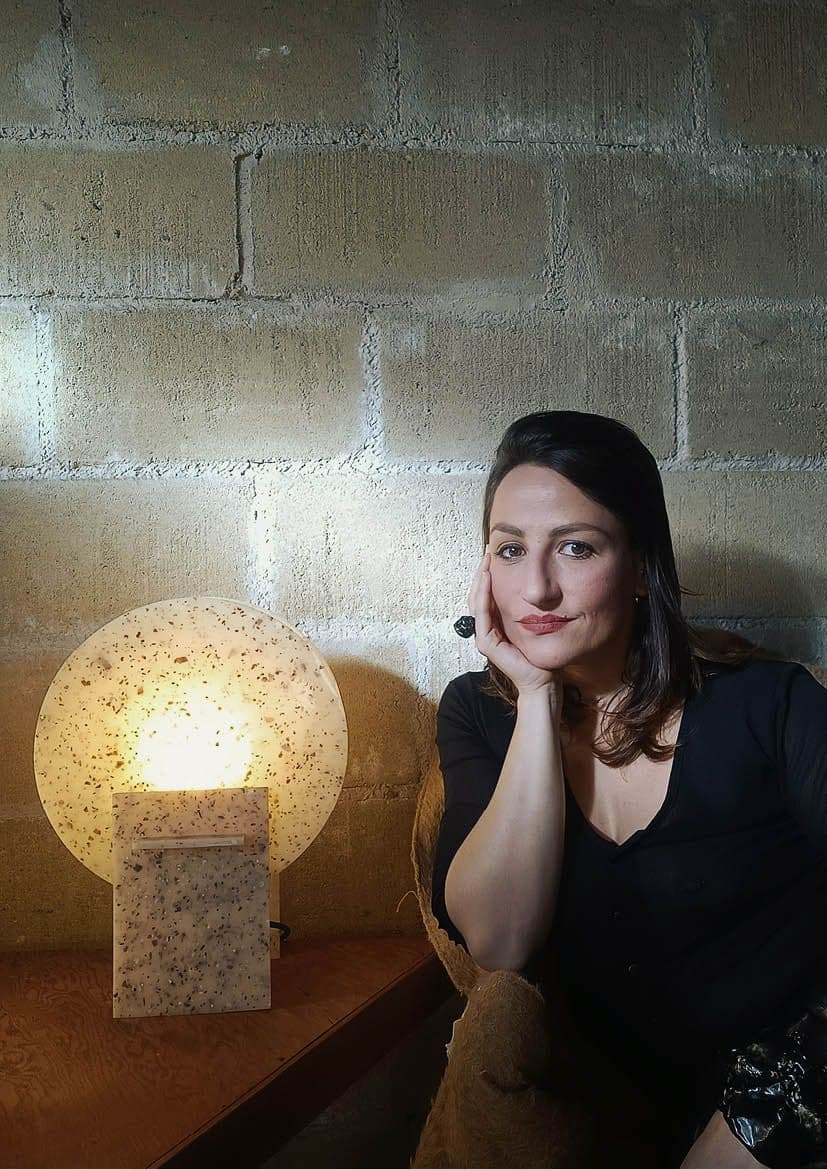Key Points
- Materials: Vegetal Glass® + micronised oyster/mussel shells form mineral–plant composites with durability and natural iridescence.
- Process: Shells are sorted, cleansed, micronised (CaCO₃), then blended with Vegetal Glass® + natural pigments; no synthetic adhesives or petrochemical inputs in the core.
- Performance: 100% plant-derived polymers with low thermal expansion, higher rigidity than glass once cured, moisture resistance via natural crosslinking; compostable/ recyclable end-of-life.
- Manufacturing: Low-temperature blowing mimics glass; mechanical interlocks/modular design enable metal–bio assemblies and easy disassembly.
- Design stance: “New wisdom” = slow, circular luxury, pieces built for emotional longevity rather than speed or spectacle.
Full Interview with Clémence Joséphine Touzet
1. Your products are made from plant matter and shells. How do these materials compare to traditional ones in terms of durability and aesthetic appeal?
Our Vegetal Glass® and mineral composites: born from oyster and mussel shells, overturn the assumption that durability must be tied to synthetic or extractive sources. Properly stabilized, they resist time with elegance. Aesthetically, they deliver textures, iridescence, hues no industrial process could dream of imitating. Each piece is singular, a testament to what we call living luxury.

2. Censis Rubliss emphasizes a “new wisdom” in consumption. Could you elaborate on how this philosophy manifests in your product development and customer engagement?
For us, “new wisdom” is a rebellion against speed. We cultivate slow reverence, designing objects that inspire emotional connection rather than impulse. Every client enters into dialogue with the materials: their origin, their story, their journey. This intimacy transforms ownership into an act of resistance against today’s economy of excess.

3. What specific chemical or mechanical processes are involved in transforming oyster and mussel shells into usable materials for design and accessories?
We begin with meticulous sorting and cleansing of shells, then micronize them into calcium carbonate powder or fragments, depending on the desired texture. Blended with Vegetal Glass® and natural pigments, the composite can be blown, cast, or polished. Crucially, no synthetic adhesives or petrochemical inputs touch the core material.

4. What are the key structural and thermal properties of the bio-sourced plant matter you use, and how do they influence the durability and functionality of your products?
Our 100% plant-derived polymers boast a low thermal expansion coefficient and greater rigidity than glass once cured. Moisture resistance comes from natural crosslinking. These qualities make them fit for fashion accessories, design objects, architectural panels,: resilient indoors or outdoors, yet fully compostable or recyclable.

5. What are the challenges of integrating 24-carat fine gold-plated brass and aged silver-plated metals with bio-sourced materials in terms of adhesion, durability, and recyclability?
It’s a delicate dance between organic softness and metallurgical precision. Metals and bio-sourced matter expand differently, so we rely on mechanical interlocks or custom-fit castings, never glue. Durability is reinforced with protective edges, while modular design ensures metals and organic cores can be separated for revalorization at end-of-life.

6. How do the material properties of black agate and white pearl influence the design and manufacturing processes of your rings and earrings compared to purely organic components?
Our so-called black agate and white pearl are not mined stones, but recycled oyster and mussel shells, reborn into luminous matter. Their mother-of-pearl rivals the chemical and visual qualities of gemstones, without the environmental cost of quarrying.

7. For the COUREAUX vases, which are blown like glass, what challenges did you encounter in mimicking the characteristics of glass using biobased materials?
Two years of experimentation led us here. Unlike silica, Vegetal Glass® reacts differently under heat, yet with hybrid techniques, we learned to blow it at low temperatures using traditional blowpipes. The result: the fluidity and clarity of glass, without the mines.

8. Your jewelry, like the KALI earrings, uses certified vegetal materials. How do these plant-based materials compare to conventional metals in terms of longevity and wearability?
Surprisingly robust, yet lighter than metals, our vegetal materials enhance comfort, essential for earrings. Each piece warms and lives with its wearer. It’s a poetic approach to durability, where adornment is not cold permanence but living resonance.

9. The MONADRE lampshade is designed to avoid excessive glue use. How do you achieve this construction method, and what benefits does it provide in terms of sustainability?
Since petrochemical adhesives remain toxic, and natural ones lack long-term strength, we devised a Vegetal Glass® welding system for the MONADRE Table Lamp. This method minimizes harmful inputs and proves that even lighting design can sidestep compromise.

10. How do you hope to influence the broader design and fashion industries with your commitment to bio-sourced materials and circular economy principles?
We reject the idea that luxury must be carved from quarries, mines, or animal life. By elevating waste into beauty: oyster shells into opulence—we rewrite the design hierarchy. With Censis Rubliss, we are crafting a circular, poetic alternative, where materials come with biographies, not just functions. Our hope is to inspire a new generation to innovate without violence, to privilege slowness over spectacle.








